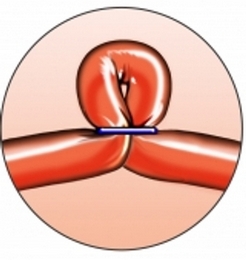Endoscopic ligation of esophageal varices
Description ligation of esophageal varices
Gastric varices – abnormal blood vessels (veins), which develop in the esophagus. They have abnormally thin walls, and blood pressure they are very high. This combination makes esophageal varices very dangerous, because they can burst and cause life-threatening bleeding.
Endoscopic ligation – Use elastic gum for the treatment of varicose veins. This is done through the upper gastrointestinal endoscopy gastrointestinal tract.

Reasons for the ligation of esophageal varices
This procedure is performed for the treatment of esophageal varices. If the disorder is not treated, Extended Vienna can rupture and cause severe bleeding.
Possible complications of endoscopic ligation of esophageal varices
Complications are rare, but no procedure does not guarantee the absence of risk. If you plan to perform ligation, you need to know about possible complications, which may include:
- Painful swallowing;
- Bleeding;
- Damage to the esophagus;
- Infection.
Some factors, that may increase the risk of complications:
- Alcoholism;
- Coagulation failure;
- Active bleeding;
- Advanced age;
- Diseases of the heart or lungs;
- The use of some drugs;
- Smoking.
How is the endoscopic ligation of esophageal varices?
Preparation for the procedure
- Doctor, probably, appoint the following:
- Medical checkup;
- Blood tests;
- Do not eat on the way from 8 to 12 hours before the procedure;
- If you have diabetes, Ask the doctor, whether you can take medication before surgery;
- It is necessary to organize the return home from the hospital. You do not have to drive for 24 hours after treatment;
- Consult your doctor about the drugs taken. A week before surgery you may be asked to stop taking some medicines:
- Anti-inflammatory drugs (eg, aspirin);
- Blood thinners, such as clopidogrel or warfarin.
Anesthesia
- Local anesthesia – you can provide an analgesic as a rinse or spray for the throat;
- Depressant – to help you relax;
- Sedation – injected through the IV. This will help you relax. Introduced as painkillers, to relieve pain during the procedure.
Procedure endoscopic ligation of esophageal varices
To perform this procedure, you will put on his left side. In the mouth it is placed a special spreader, to keep it open. Assistant doctor will monitor your breathing and heart rate. You can be assigned to the flow of oxygen through the nose. The suction tube is used to remove saliva and other fluids from your mouth.
An endoscope with a small lamp and a camera on the end through the mouth and throat is introduced into the esophagus. Field operations will be covered. The doctor will watch the images on the screen of the esophagus. Through the endoscope will supply air, to widen the esophagus and help the doctor better see its walls. The doctor can detect enlarged veins.
Through the endoscope served surgical instruments. The increased area of tissue is sucked into the device's camera. One or more hinges are placed around tissue, to deprive it of its blood supply.
How long will the endoscopic ligation of esophageal varices?
Usually, The operation takes less than an hour.
Will it hurt during endoscopic ligation of esophageal varices?
You, usually, patients during the procedure feel some pressure and discomfort (but no pain). After the procedure, can be felt in the throat irritation and slight pain.
Care after endoscopic ligation of esophageal varices
Care in a hospital
You will be taken to the House for restoration, until after the effect of the drug administration. In most cases, it will take about an hour. If you feel good, You can go home.
Home Care
Returning home, you should do the following:
- Follow your doctor's instructions regarding the diet;
- Avoid driving or using machinery for at least a day after the procedure, because the sedatives may slow response time;
- Avoid alcohol, at least a day after treatment;
- Get plenty of rest.
After a few days or weeks after the procedure, cloth, which was bandaged, exfoliates.
Contact your doctor after endoscopic variceal ligation
After returning home, you need to see a doctor, If the following symptoms:
- Signs of infection, including fever and chills;
- Bleeding from the mouth;
- Increased pain;
- Nausea and vomiting;
- Hematemesis;
- Difficulty swallowing;
- Cough, shortness of breath or chest pain;
- Dizziness and weakness;
- Bloody or dark black stools;
- Severe abdominal pain.
